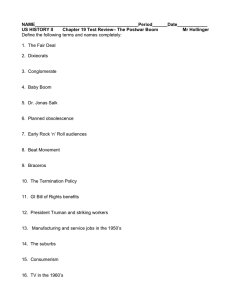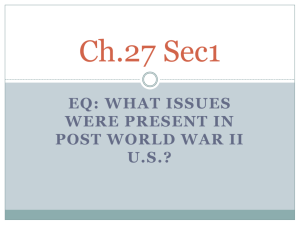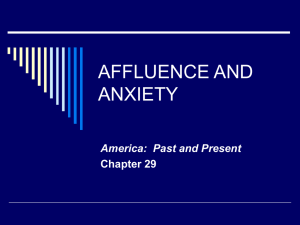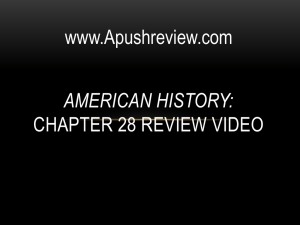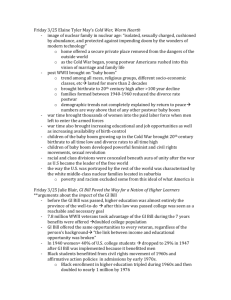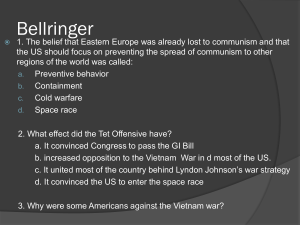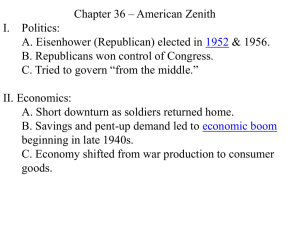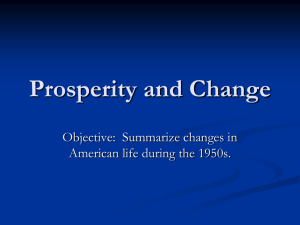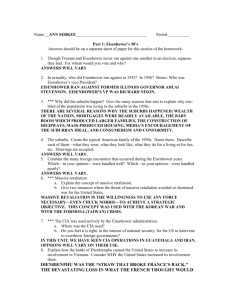Chapter 29: Affluence and Anxiety
advertisement
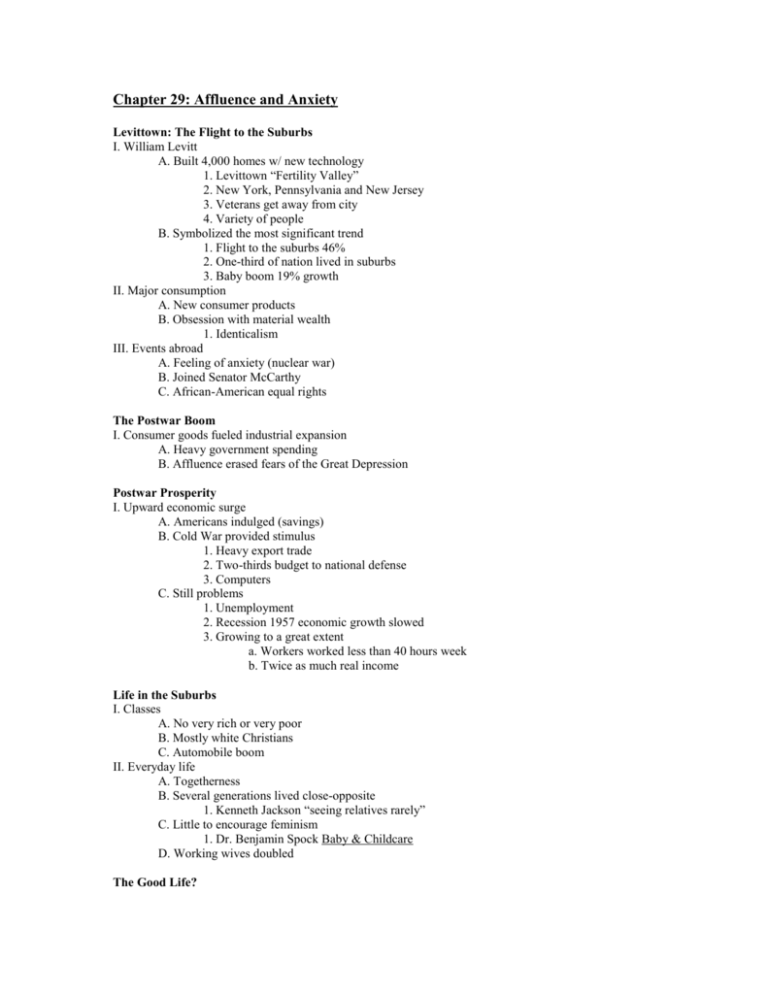
Chapter 29: Affluence and Anxiety Levittown: The Flight to the Suburbs I. William Levitt A. Built 4,000 homes w/ new technology 1. Levittown “Fertility Valley” 2. New York, Pennsylvania and New Jersey 3. Veterans get away from city 4. Variety of people B. Symbolized the most significant trend 1. Flight to the suburbs 46% 2. One-third of nation lived in suburbs 3. Baby boom 19% growth II. Major consumption A. New consumer products B. Obsession with material wealth 1. Identicalism III. Events abroad A. Feeling of anxiety (nuclear war) B. Joined Senator McCarthy C. African-American equal rights The Postwar Boom I. Consumer goods fueled industrial expansion A. Heavy government spending B. Affluence erased fears of the Great Depression Postwar Prosperity I. Upward economic surge A. Americans indulged (savings) B. Cold War provided stimulus 1. Heavy export trade 2. Two-thirds budget to national defense 3. Computers C. Still problems 1. Unemployment 2. Recession 1957 economic growth slowed 3. Growing to a great extent a. Workers worked less than 40 hours week b. Twice as much real income Life in the Suburbs I. Classes A. No very rich or very poor B. Mostly white Christians C. Automobile boom II. Everyday life A. Togetherness B. Several generations lived close-opposite 1. Kenneth Jackson “seeing relatives rarely” C. Little to encourage feminism 1. Dr. Benjamin Spock Baby & Childcare D. Working wives doubled The Good Life? I. Consumerism-dominant social theme II. Quality of life-anxious and dissatisfied Areas of Greatest Growth I. Organized Religion A. Flourished- more attendance 1. Protestant, Catholic, Jewish 2. Religious writer, Norman Peale a. filled genuine and shallow human need II. Schools A. Demands for federal aid B. Eisenhower reluctance to unbalance the budget C. Called for sweeping reforms 1. desirability for college education III. Television A. Pushed radio aside B. Controlled by 3 networks 1. advertisers C. Burst of creativity D. Charles Van Doren- given answers Critics of the Consumer Society I. Self-criticism A. John Keats’ The Crack in the Picture Window B. Richard Gordon, Katherine G & Max Gunther 1. Psychological toll of the suburban life 2. Book split Level Tramp C. William H Whyte’s The Organization of Men 1. “The Team”& “Belongingness” 2. Loss of personal identity D. David Riesman The Lonely Crowd 1. Conform to social pressures E. C. Wright Mills 1. White over blue collar workers 2. White Collar & Powerelite 3. Corporation the villain for Mills F. The Beats 1. Literary groups that rebelled against materialistic society 2. Jack Kerouac’s On the Road 3. Bizarre activity 4. Poet-Lawrence Ferlinghetti 5. Abstract expressionism a. Jackson Pollock, Mark Rothko Farewell to Reform I . Grievance, cry for change II. Turned away from federal regulations and welfare programs Truman and the Fair Deal I . Tried to follow the New Deal A. New areas of reform B. Fair Deal 1. Medical insurance for all 2. Compulsory fair employment practices commission 3. Federal aid to education 4. Defeat after defeat 5. Only success in social security- 10 mil more & 75¢ a. conservative coalition blocked success b. tried too much too soon Eisenhower’s Modern Republicanism I. Moderation A. Keynote of Eisenhower’s presidency B. Goal to restore calm C. Balancing budget D. Keep new deal 1. Modern Republicanism 2. Conservative with money, Liberal with humans II. Domestic A. Passive Role B. Concentrated on the Cold War C. Corporation executives 1. George Humphrey-Sec of Treasury, fiscal stringency 2. Chalres E. Wilson- Sec of Defense, Pentagon budget D. Reluctant to be active with Congress 1. Rely on two Texas Democrats: Lyndon B. Johnson & Sam Rayburn 2. Modest legislative record 3. Created the Dept. of Health 4. First woman in cabinet: Oveta Culp Hobby E. Highway Act of 1956 1. Justified by the National Defense 2. Stimulated economy faster F. Spending to restore prosperity The Struggle over Civil Rights I. National Conscience arose A. African-Americans benefited from WWII B. Segregated neighborhoods C. Rising standards-challenge old patterns D. Totally segregated in the South Civil Rights as a Political Issue I. Truman A. First to attempt to alter history 1. Civil rights 2. Backed by African-Americans a. blocked by southern opposition 3. Added Civil Rights to the liberal agenda 4. Desegregation of armed forces-army resisted Desegregating the Schools I. Schools A. Primary target of Civil Rights 1. College admission 2. Thurgood Marshall challenged Supreme Court a. Psychological damage 3. Brown vs. Board of Education a. Earl Warren-difficult to change b. Resistance c. Pupil placement laws II. Presidential support A. Lack of support weakened B. Worked quietly 1. Thought of as support 2. Little Rock Nine C. Permanent commission for Civil Rights The Beginnings of Black Activism I. Beginning A. Rosa Parks- Dec 1 1955 Montgomery, Alabama 1. Bus boycott B. Massive protest movement 1. Martin Luther King Jr. – led boycott a. Didn’t challenge legality b. Victory c. Southern Christian Leadership conference d. Unite community e. Joann Robinson, Ella Baker C. Sit-ins 1. Student Non-violence Coordinating Committee a. Replace NAACP Conclusion: Restoring National Confidence I. Goals A. Objectives for the next decade 1. Henry W. Wriston 2. Increased military spending 3. Broader education 4. Advancement of the arts II. Less troubled
